by David Elliott
Have I mentioned recently how much I love teaching fourth grade, especially from February on? Well, I am and I do.
Earlier in the year, I shared Blake's "The Tyger" with my students, along with the way-cool
video interpretation I first saw at Tabatha's blog, The Opposite of Indifference.
Our focus right now in Reading Workshop is "Reading to Learn." I decided to take a break from conferring and read alongside my students yesterday. I'm reading poetry to learn to be a better poet. I was sitting at a table with some students, reading David Elliott's IN THE WILD, and taking notes in my notebook when I came to his poem, "Tiger." I'm not sure why I never noticed it before, but I was struck by the way his poem made me think again about Blake's. (And I vowed that someday I, too, will write a poem that makes the reader think of a famous poem.)
A., whose favorite animal is the tiger, overheard me talking about the poem with N. (who tried a few dictionary poems with me in early April). He came over and told me about getting chills when he heard Blake's poem for the first time -- the part (and he quoted) "about 'Tyger, Tyger burning bright/in the forests of the n
Here’s another review of a Cybils Nonfiction Picture Book finalist …

Jenkins, Martin. 2011. Can We Save the Tiger? Ill. By Vicky White. Somerville, MA: Candlewick.
Martin Jenkins explains extinction and its causes in a manner that, while factual, is also conversational and thought provoking. Consider his opening paragraphs that inspire an immediate sense of wonder combined with an easy familiarity,
The world’s quite a big place, you know. But it’s not that big, when you consider how much there is to squeeze into it.
After all, it’s home not just to billions of people, but to the most amazing number of other kinds of living things, too. And we’re all jostling for space.
After a cursory introduction to extinction, he offers the varying reasons for
why creatures have become extinct – poaching, invasive non-native species, over-hunting, chemical poisoning. Each time, he hints that problems are not so easily solved. Take the tiger for example,
…they’re big, they need a lot of space. But the countries where they live, like India and Indonesia, have huge numbers of people in them too, all trying to make a living and needing to be fed. …
So if you were a poor farmer trying to make a living with a couple of cows and a few goats, you might not be too happy if you found there was a hungry tiger living nearby. And if you knew that someone might pay you more for a tiger skin and some bones than you earn in three whole months working in the fields, then you might find it very tempting to set a trap or two, even if you knew it was against the law.
Jenkins looks at failures (the Dodo, the Great Auk and others), successes (the Buffalo, the White Rhinoceros, the Kakapos, and more) and other works in progress. In each case, he presents the conundrum of competing interests or unintended consequences in a manner easily understood by young readers. Text size, too, is inviting to younger readers – smaller text is punctuated by sections of very large font print.
Similarly to Jim Arnosky’s
Thunder Birds, field-style pencil sketches accompany many pages. Vicky White’s larger illustrations are done in pencil and oil paint with lightly sketched backgrounds, or on plain cream-colored pages. The large and realistic illustrations are accompanied by basic facts including habitat, size, diet, life span, and existing population. An index and online resources complete the book.
A small final illustration of the rare Sander’s Slipper Orchid hints that not only creatures are in danger of extinction; or perhaps the illustration hints at a future book. The over sized book has sturdy pages that, although they have a matte finish, have a smooth and creamy texture - like icing on the cake. A beautiful and affecting book.
3 Comments on Can We Save the Tiger? a review, last added: 2/20/2012

By:
Aline Pereira,
on 8/7/2011
Blog:
PaperTigers
(
Login to Add to MyJacketFlap)
JacketFlap tags:
Picture Books,
India,
Tigers,
animal conservation,
Cultures and Countries,
Week-end Book Reviews,
Dorje's Stripes. Anshumani Ruddra,
Gwanjo Park,
Jung-a Park,
royal bengal tiger,
tiger conservation,
Add a tag
 Anshumani Ruddra, illustrated by Gwangjo and Jung-a Park,
Anshumani Ruddra, illustrated by Gwangjo and Jung-a Park,
Dorje’s Stripes
Kane Miller, 2010/ 2011
Ages 5-9
A small Buddhist monastery nestled in the mighty Himalayas is surrounded by a vast forest. “Everything about the place spoke of quiet beauty,” reads the first page of Dorje’s Stripes. Perhaps the most quietly beautiful aspect of the monastery is its most unusual resident: a Royal Bengal Tiger named Dorje.
When Dorje arrived, Master Wu explains, he was weak and had not eaten for days. Upon regaining his strength under the monks’ care, Dorje began hunting for himself again, but every time he returned from the jungle, he had one less stripe. Eventually, he was left with nothing but two little dark spots above his eyes, but this evening Cheekoo, the youngest monk, notices that a new stripe has appeared on Dorje’s shoulders! What could it mean?
Master Wu tells the monks that he entered Dorje’s dreams shortly after his arrival and learned that the tiger’s clan was disappearing as a result of greedy hunters attacking tigers for sport and also hunting their prey. The mighty cats who escaped slaughter were left to starve. Every time one of his clan died, Dorje lost a stripe. Dorje’s new stripe fills the monks with great hope as Master Wu reveals that he and Dorje discovered a female tiger that morning as they walked in the forest.
A note that follows this story, beautifully illustrated in lush watercolors by the Korean team of Gwungjo and Jung-a Park, explains the plight of the Royal Bengal Tiger, India’s national animal. Less than 1,500 wild tigers live in the mangrove forests of the Sundarbans in Bengal today, having been hunted from a population of more than 40,000 at the beginning of the twentieth century. This powerful and majestic animal is now one of the Earth’s most threatened species, but the story of Dorje is one of hope. “Dorje only knew cruel men before he met us,” explains Master Wu, but just as the tiger – and perhaps eventually his clan – recovers under the monks’ care, so can future generations work to change the fate of this beautiful animal.
Abigail Sawyer
August 2011
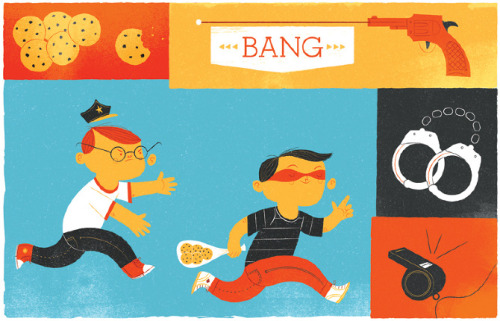
I tripped over Lydia Nichols’s work on Dribbble, and afterwards I had to go through each and every image in her portfolio. Completely worth the visit! Her illustrations, design, and lettering are all great colors and wonderful organic shapes. Such fun work!
I have a thing for tigers too, so this Colonel Windpipe contribution made me all warm and fuzzy as well:



Tiny Little Fly by Michael Rosen, illustrated by Kevin Waldron
British Children’s Laureate Michael Rosen has created another delight of a picture book. Readers follow the adventures of Tiny Little Fly as he buzzes past some impressive animals. Great Big Elephant tries to catch the fly, but even with all of his tramping and crushing, the fly flies away. When Tiny Little Fly lands on Great Big Hippo’s ear, the hippo tries to catch him by rolling and squashing. But the fly flies away. Even Great Big Tiger, who swoops and snatches at the fly with his pay cannot catch the fly. Told in a wonderful rhyme with plenty of noise and fun, this book will be right at home in any toddler story time.
Rosen’s verse here is filled with a sense of fun and playfulness. The repetition in the book gives it a wonderful pace and gait that is a pleasure to read aloud. Each large animal takes two winks at the fly, then tries in their own way to catch it with plenty of ruckus. Thanks to the simplicity of the story and the attraction of the large animals, I can see this being made into a felt board story very easily. It would also convert well into a little play acting with parents or teachers.
Waldron’s illustrations are simple but sophisticated. They have a mix of timelessness and modernism that is charming. His use of a natural-feeling background rather than stark white makes for a warm feel throughout the book. Waldron combines several techniques in these illustrations from ink drawings to paint. For reading aloud to a group, Waldron’s illustrations work well thanks to their large size. Additionally, he allows children to guess what the next large animal will be, adding to the pleasure of sharing the book aloud.
An ideal story time pick, get this one for any insect, tiger, elephant or hippo story time you are planning. Heck, it’s good enough to use time and again for any reason at all. A guaranteed hit with the toddler and preschool set. Appropriate for ages 2-5.
Reviewed from library copy.

Read to Tiger by S. J. Fore, illustrated by R. W. Alley
Turn on the light, curl up on the couch, open your book, you are ready to read. But what’s that noise?! A tiger is behind the couch chomping on gum! This little boy has one naughty tiger to deal with just as he is settling in for a great read. After the tiger stops chewing him gum loudly, the tiger growls pretending to be a bear. Then the tiger starts practicing his karate, with great yells and high kicks. The tiger then choo-choos past on a train. And finally picks up the couch itself to look for his whistle. Finally, the little boy has had enough but just then, the tiger gets a glimpse of the book the boy has been trying to read and its picture of a tiger. Which may finally be what it takes to keep tiger quiet: a great story shared with a friend.
The humor of this book is evident from the very first encounter with the tiger. Wonderfully, the zaniness increases as the story goes on, and children are definitely going to be laughing out loud by the time Karate Tiger leaps onto the page. Fore has tapped into the glee that readers feel when they see the humor in a situation before the narrator in the book does. They will delight in it. Fore also has a wonderful pacing to the book with the tiger doing something disruptive, the boy correcting him, and then settling again to read his book, only to have the tiger do something even more outrageous.
Alley’s illustrations add to the action and wild abandon of the book. Alley’s use of subtle colors next to bright allows readers to feel the snuggly reading time and then to be jolted in turn by tiger and his red and yellow coat in full action. So much of the humor is visual here, and very successfully so.
If you are looking for a book about the pleasures of reading that is funny and filled with plenty of action, this is it. Even better, it is the sort of book that itself proves exactly why reading is fun. Appropriate for ages 4-6.
Reviewed from copy received from Viking.

Melbourne illustrator Melanie Matthews has given herself quite the challenge for the year: 365 cartoons – 1 a day for the entire year. She kicked things off with this awesome tiger, presumably because it is the year of the tiger on the Chinese calendar.

Although, it is quite possible that she just loves tigers, as her portfolio is full of them! And that’s a good great thing.
Posted by David Huyck on Drawn! The Illustration and Cartooning Blog |
Permalink |
No comments
Tags: cartoons, Melanie Matthews, tigers

 Working to get lot's done this weekend. I lost a full day of work yesterday because Henry got sent home from day care do to barfing so I lost a whole day of work. I need to catch up, especially on the kids book I'm working on, which the sketch above is from.
Working to get lot's done this weekend. I lost a full day of work yesterday because Henry got sent home from day care do to barfing so I lost a whole day of work. I need to catch up, especially on the kids book I'm working on, which the sketch above is from.
Hello, all you Cowpokes out there in The Land of Blog, it's me Bad Bart Bill!!!!!! The shooten-ist, ropin'-ist, cattle-stealingest bandito south of the Mason-Dixon Line!!!!! Yep, I'm a fairly dangerous character ifin ya get my drift!!!!!! If ya want to see me in action, check out this little trailer here (I'm the guy with the cigar and poncho. Also I go by another name; Clint Eastwood).
Pretty Cool Right!!!!!! I'm a Good/Bad Man and ifin ya say different, get ready to draw Pilgrim!!!!!!
And now for some book reviews: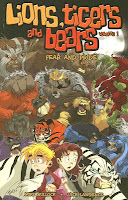 Lions, Tigers and Bears (Volume 1): Fear and Pride – Joey and his mother are moving out of his Grandmother’s house. Joey is afraid because he knows there are monsters underneath beds and hiding in closets and without his Grandmother’s presence, he knows that they will get him. Fortunately for Joey, his Grandmother knows these things to be real also. As a going away present, she gives him a package with four stuffed animals called The Night Pride. The Night Pride consists of Pallo - Leader of the Pack (a Lion), Venus – Guardian of the Pride (a Bengal Tiger), Minerva – Huntress of the Shadows (a Black Panther) and Aries – Warrior of the Night (a Siberian Tiger). These stuffed animals come to life whenever a child is in danger from Evil Beasties that come out in the night. One night, from out of his new closet in his new bedroom, two Evil Beasties, Mumbler and Grumbler, attack and Joey’s Night Pride comes to full-blown life to defend him. When the fight is over, Joey finds himself in the world where stuffed animals are real all the time. This is just the beginning of a wonderful book that is really great fun and promises further volumes in the near future.
Lions, Tigers and Bears (Volume 1): Fear and Pride – Joey and his mother are moving out of his Grandmother’s house. Joey is afraid because he knows there are monsters underneath beds and hiding in closets and without his Grandmother’s presence, he knows that they will get him. Fortunately for Joey, his Grandmother knows these things to be real also. As a going away present, she gives him a package with four stuffed animals called The Night Pride. The Night Pride consists of Pallo - Leader of the Pack (a Lion), Venus – Guardian of the Pride (a Bengal Tiger), Minerva – Huntress of the Shadows (a Black Panther) and Aries – Warrior of the Night (a Siberian Tiger). These stuffed animals come to life whenever a child is in danger from Evil Beasties that come out in the night. One night, from out of his new closet in his new bedroom, two Evil Beasties, Mumbler and Grumbler, attack and Joey’s Night Pride comes to full-blown life to defend him. When the fight is over, Joey finds himself in the world where stuffed animals are real all the time. This is just the beginning of a wonderful book that is really great fun and promises further volumes in the near future.
 Star Wars: The Last of The Jedi – The Desperate Mission by Jude Watson – This is the first book in “The Last of The Jedi” Series. The Clone Wars are over and Emperor Palpatine along with Darth Vader rule supreme. The Jedi are all but extinct, having either been betrayed by the deadly Order 66 and killed by the very Republic Clone Troopers under their command, or hunted down and killed by Lord Vader. Obi-Wan is one of the few Jedi remaining alive and his mission is to ensure that young Luke, who is being raised on Tatooine by his Aunt and Uncle, is kept safe from the Empire until he is of age to make a difference in the future. While on Tatooine caring out this duty, he hears that an old acquaintance named Ferus Olin, who at one time was a padawan but walked away from the Jedi Order before the end of the Clone Wars, is in deep trouble on the planet Bellassa. With the help of an “old friend” he is convinced he must leave Tatooine temporarily to help Ferus. Little does he know all that this “help” will involve. This is a great read and a great series and I highly recommend it to all!!!!!
Star Wars: The Last of The Jedi – The Desperate Mission by Jude Watson – This is the first book in “The Last of The Jedi” Series. The Clone Wars are over and Emperor Palpatine along with Darth Vader rule supreme. The Jedi are all but extinct, having either been betrayed by the deadly Order 66 and killed by the very Republic Clone Troopers under their command, or hunted down and killed by Lord Vader. Obi-Wan is one of the few Jedi remaining alive and his mission is to ensure that young Luke, who is being raised on Tatooine by his Aunt and Uncle, is kept safe from the Empire until he is of age to make a difference in the future. While on Tatooine caring out this duty, he hears that an old acquaintance named Ferus Olin, who at one time was a padawan but walked away from the Jedi Order before the end of the Clone Wars, is in deep trouble on the planet Bellassa. With the help of an “old friend” he is convinced he must leave Tatooine temporarily to help Ferus. Little does he know all that this “help” will involve. This is a great read and a great series and I highly recommend it to all!!!!!
 Flight Explorer: Volume 1 edited by Kazu Kibuishi – This is really a wonderful collection of short stories by extremely talented and inventive writers and illustrators collected in one Graphic Novel. Some of my favorite stories in the collection (although I really liked them all) were Missile Mouse in “The Guardian Prophecy” (lots of action and adventure), Fish N Chips in “All in a Day’s Work" (Get this; a cat and a fish are galactic protectors of the planet Earth. Sounds funny, right? Well, the story is even funnier than you think. I just love it.) and “Big Mouth” (this one is so hilarious that I’m not even going to try and explain it; just read it). Do yourself a favor and give this Graphic Novel a try. The art work and stories will blow you away. You will not regret it, I promise!!!!!
Flight Explorer: Volume 1 edited by Kazu Kibuishi – This is really a wonderful collection of short stories by extremely talented and inventive writers and illustrators collected in one Graphic Novel. Some of my favorite stories in the collection (although I really liked them all) were Missile Mouse in “The Guardian Prophecy” (lots of action and adventure), Fish N Chips in “All in a Day’s Work" (Get this; a cat and a fish are galactic protectors of the planet Earth. Sounds funny, right? Well, the story is even funnier than you think. I just love it.) and “Big Mouth” (this one is so hilarious that I’m not even going to try and explain it; just read it). Do yourself a favor and give this Graphic Novel a try. The art work and stories will blow you away. You will not regret it, I promise!!!!!
Well, until next time all. Happy Trails,
Bad Bart Bill

By: Rebecca,
on 10/16/2007
Blog:
OUPblog
(
Login to Add to MyJacketFlap)
JacketFlap tags:
Reference,
oxford,
A-Featured,
Online Resources,
online,
french,
Dictionaries,
typing,
meuf,
nonante,
“maillot,
kiffe,
resources”,
bleus,
“hint,
Add a tag
Happy Dictionary Day! In honor of this wonderful holiday we thought we would introduce you to the Oxford Language Dictionaries Online (OLDO). With over 1.4 million words and phrases you could spend the whole day (and even the whole year) exploring other languages. Lucky for you, OLDO is free through Sunday the 21st. Use this link to start your word travels. Throughout the day we will be have some fun quizzes to help you expand your vocabulary in French, German, Spanish and Italian. First up is French. Try the questions below and then hit “more” to see how well you did. If you are stuck use OLDO for help!
Question 1: A Belgian French student tells you she has “une heure de fourche” today. What does she mean?
Question 2: French has two words that translate the English river - what’s the difference between them?
Question 3: Which French speakers would refer to France’s victory in the 1998 FIFA World Cup as being in “nonante-huit”?
Question 4: When would you hear people shouting “allez les Bleus”?
Question 5: Most English speakers know the French word “eau”; but what is special about “eau de vie”?
(more…)
Share This




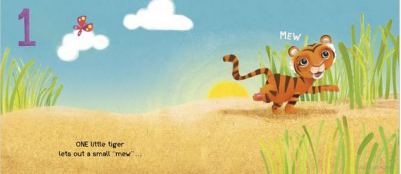


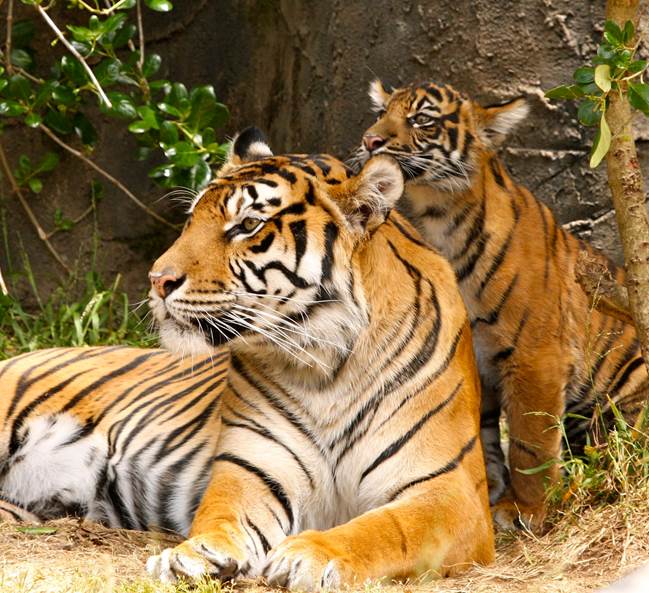
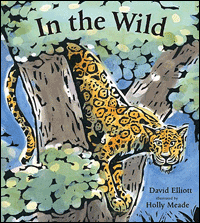

 Anshumani Ruddra
Anshumani Ruddra









I have always loved that Blake poem too. What wonderful students you have!
Every time I read something about your classroom, I wish I lived in Ohio and could come and see your brilliance personally. You are amazing! This story gives me goosebumps!
Oh my gosh, Mary Lee - your recounting of your student's comments give ME chills! That's a lot of chills for an old poem. (And we have to throw in Carol's goosebumps, too.) You have cultivated room for wonder in your classroom, and that's magical. I love IN THE WILD - a gorgeous book. [Blake's tyger has followed me around since the first time I met it, too, many moons ago. I missed the wild video at Tabatha's; thanks for sharing here.]
That story gave me chills, too. It's so magical when kids connect with poems viscerally.
Hi ML! Great pair of poems, and thanks for sharing the classroom story. -Ed
Save the tigers!
I posted lyrics from Matt Nathanson's song All We Are today at Bildungsroman:
http://slayground.livejournal.com/699647.html
http://slayground.livejournal.com/699647.html
Wonderful post, Mary Lee! Hadn't seen Elliot's poem's before so that was a real treat -- Blake's poem is still magical. Didn't encounter it until college though. I envy your 4th graders!
Great story, Mary Lee. We really don't know what someone is taking in, maybe even what they are saving for a rainy day.
How wonderful your fourth-graders are already haunted by poetry. May it never end.
A few years ago, were you at the Library of Congress with the kidlit bloggers when they brought out a Tyger manuscript for us to ogle?
What a story for your journals Mary Lee, to capture for sharing again & again with other students. Very well done!
Your influence extends well beyond your knowing. Good teachers are like that. Thank you for all you do with those young ones in your classroom.
It's that last quarter, they seem to arrive somehow .... Book clubs, for instance, have become so fascinating to listen into. It always seems so unfair that this quarter seems to fly by the fastest!
I have read the Blake poem a number of times of the years and still don't have a clue what it is about! LOL I like Elliott's poem. Nice comparison.
I am not even sure where to start...awesome video, love your chilling moment with A (that is the best), both poems are so thought provoking, I love the Elliott poem "they are wild and distant, the tiger and the star. Love it all!
My daughter is in fourth grade and she is enjoying poetry greatly. She is familiar with this Blake poem primarily because we watch the TV series 'The Mentalist' (hehehehe, i know i know) and this poem has always been used in that TV show. One of my favorite poem by William Blake. Thank you for sharing this. :)
It's so wonderful seeing students respond to words. I love it. I can live for days on one moment like that. Thanks for sharing it!